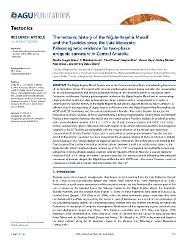| dc.contributor.author | Çinku, Mualla Cengiz | |
| dc.contributor.author | Hisarlı, Z. Mümtaz | |
| dc.contributor.author | Yılmaz, Yücel | |
| dc.contributor.author | Ülker, Beyza | |
| dc.contributor.author | Kaya, Nurcan | |
| dc.contributor.author | Öksüm, Erdinç | |
| dc.contributor.author | Orbay, Naci | |
| dc.contributor.author | Özbey, Zeynep Üctaş | |
| dc.date.accessioned | 2019-06-27T08:01:50Z | |
| dc.date.available | 2019-06-27T08:01:50Z | |
| dc.date.issued | 2016 | |
| dc.identifier.issn | 0278-7407 | en_US |
| dc.identifier.issn | 1944-9194 | en_US |
| dc.identifier.uri | https://hdl.handle.net/20.500.12469/480 | |
| dc.identifier.uri | https://doi.org/10.1002/2015TC003956 | |
| dc.description.abstract | The Nide-Krehir Massif known also as the Central Anatolian Block is bordered by the sutures of the Neotethys Ocean. The massif suffered several deformation phases during and after the consumption of the surrounding oceans and the postcollisional events of the continental pieces of Anatolia in latest Cretaceous to Miocene. Previous paleomagnetic studies on the Nide-Krehir Massif and its surroundings displayed either insufficient data or have claimed large rotations and/or remagnetization. In order to understand the tectonic history of the Nide-Krehir Massif and its adjacent blocks we have sampled 147 different sites in the age range of Upper Jurassic to Miocene from the Nide-Krehir Massif throughout its W/SW and E/SE boundaries and the central-southeastern Taurides. The results display that except the limestones in central Taurides all rocks examined carry a primary magnetization. Among these an important finding is that rotations between the massif and the central-eastern Taurides indicate an oroclinal bending with counterclockwise rotation of R=41.1 degrees 7.6 degrees in the SE and clockwise rotation of R=45.9 degrees 9.3 degrees in the central Taurides from Upper Cretaceous rocks with respect to the African reference direction. Paleomagnetic rotations in the SE Taurides are compatible with the vergent direction of the thrusts generated from consumption of the Intra-Tauride Ocean prior to postcollisional convergence between Taurides and the massif. In the central Taurides it has been shown that the clockwise rotation of 45.9 +/- 9.3 started in Middle Eocene because of a remagnetization in Upper Cretaceous limestones. The deformation was linked to the final closure of the southern Neotethys and the collision between the African and Eurasian plates. In the Nide-Krehir Massif counterclockwise rotation up to 25.5 degrees +/- 7.3 degrees is recognized during Middle Eocene and interpreted in terms of block rotation together with the Taurides. After the Miocene a counterclockwise rotation of 16.8 degrees +/- 3.9 degrees along the Eastern Taurides shows that this area was mostly affected by the westward movement of Anatolia despite the Nide-Krehir Massif and its SW/W areathe central Taurideswhich is recognized as stable with counterclockwise rotation less than 10 degrees. | en_US] |
| dc.language.iso | eng | en_US |
| dc.publisher | Amer Geophysical Union | en_US |
| dc.rights | info:eu-repo/semantics/openAccess | en_US |
| dc.subject | Paleomagnetic | en_US |
| dc.subject | Nide-Krehir Massif | en_US |
| dc.subject | Taurides | en_US |
| dc.subject | Oroclinal Bending | en_US |
| dc.subject | Paleolatitude | en_US |
| dc.subject | Rotation | en_US |
| dc.title | The Tectonic History of the Nide-Krehir Massif and the Taurides Since the Late Mesozoic: Paleomagnetic Evidence for Two-Phase Orogenic Curvature in Central Anatolia | en_US |
| dc.type | article | en_US |
| dc.identifier.startpage | 772 | en_US |
| dc.identifier.endpage | 811 | |
| dc.relation.journal | Tectonics | en_US |
| dc.identifier.issue | 3 | |
| dc.identifier.volume | 35 | en_US |
| dc.identifier.wos | WOS:000374712800013 | en_US |
| dc.identifier.doi | 10.1002/2015TC003956 | en_US |
| dc.identifier.scopus | 2-s2.0-84979486447 | en_US |
| dc.institutionauthor | Yılmaz, Yücel | en_US |
| dc.relation.publicationcategory | Makale - Uluslararası Hakemli Dergi - Kurum Öğretim Elemanı | en_US |
















